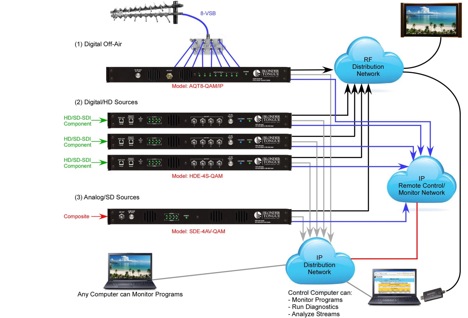Applied Technology: The Best of Both Worlds: Digital Video Encoding
Digital video encoders are much more complex than their predecessors, analog modulators, which makes them much more versatile, broadening the number of users and use cases for the same content and where it can be viewed. One of the most common applications is to use simultaneous QAM and IP outputs together to deliver RF QAM signals to traditional digital TV sets, while also delivering IP video to the desktop. Off-air local programs, locally generated studio content and even national broadcasts of other networks can all be viewed on in-house coax distribution to the televisions, and via open source players such as VLC media player through an operator’s IP network. This allows operators to expand the reach of their video monitoring without having to run additional coaxial cable throughout the building and maximize the use of their IP infrastructure. (See Figure 1.)
Figure 1 Encoder Basics
The old analog modulator takes in one source, typically baseband audio and video, and creates an analog carrier for those signals to ride on. Composite Video, Component Video, HD-SDI, ASI, VGA, and HDMI (unencrypted) are some of the signals that digital encoders can handle. With digital encoders, putting multiple programs onto a single QAM channel is desirable to maximize bandwidth usage. In addition to a QAM RF output, an IP output is available on some digital encoders. It can be run simultaneously with the QAM output, making the encoder invaluable for an operator that wants to distribute video signals on both coax and Ethernet.
Once the encoder receives the incoming signal, it encodes that signal into a digital stream, in MPEG-2 or MPEG-4 format, and packages it with specific headers. In addition to the video and audio data, there are many other pieces of data that are included in a digital Transport Stream (TS) to standardize it for viewing by decoders. Encoders like the Blonder Tongue HDE-4S-QAM provide multiple output options, including QAM, IP, and ASI. Any or all of these outputs can be utilized simultaneously.
Additional Versatility
Monitoring and setup of the encoders is all done through an IP interface and a standard Web browser, eliminating the need for specialized software. Some encoder models even come with a hot spare input, so in the event of a source failure, the spare program can be activated and the system can be restored with a few keystrokes. Remote site monitoring can be done by logging in to the corporate network from offsite, or using remote control software that enables operators to control a computer at the remote site. This allows for performance diagnostics to be run on both the IP streams and QAM channels, with products and programs such as Wireshark, or a QAM tuner card and TS Reader.
Utilizing the IP and QAM outputs of the encoder provides the best of both worlds when displaying and monitoring broadcast content in-house, not only on standard TV displays throughout the system, but using desktops and other connected devices to monitor programs, run diagnostics, and analyze streams. So whether an operator is thinking of adding to existing digital systems or putting in a brand new system, look toward the digital encoders that can offer the most versatility, with multiple program inputs and different output formats. Even if an operator is not utilizing both QAM and IP outputs today, these features may be needed tomorrow.
About the author: Wes Waite is a systems engineer for Blonder Tongue.
Sponsored Content

The professional video industry's #1 source for news, trends and product and tech information. Sign up below.
